Abstract
A carbon dioxide requirement for growth of Streptococcus sanguis was readily demonstrated in a fermentor where the gas atmosphere could be controlled. Growth at a maximum rate occurred immediately in response to the appropriate CO2 concentration; growth stopped when CO2 was deleted. Washed inocula consisting of exponentially growing cells required a minimum of 2.4% CO2, postexponential phase cells needed 1.2 to 1.8% CO2 immediately and 2.4% CO2 shortly thereafter, whereas stationary phase cells required three sequential increases in CO2 from 0.3 to 1.8 to 2.4% within the first 90 min of growth. These CO2 concentrations permitted each inoculum to initiate growth immediately at the same maximum rate. These results also showed that physiologically “old” cells had the same capacity for growth as “young” cells when the CO2 concentrations were appropriate for the type of inoculum. Continued exponential growth of the culture at the same optimum rate required 2.4% CO2. Lower concentrations of CO2 were rate limiting and the resulting exponential rate was proportional to the CO2 concentration. The “normal” lag period of S. sanguis appears to be an artifact induced by a CO2 deficiency.
Full text
PDF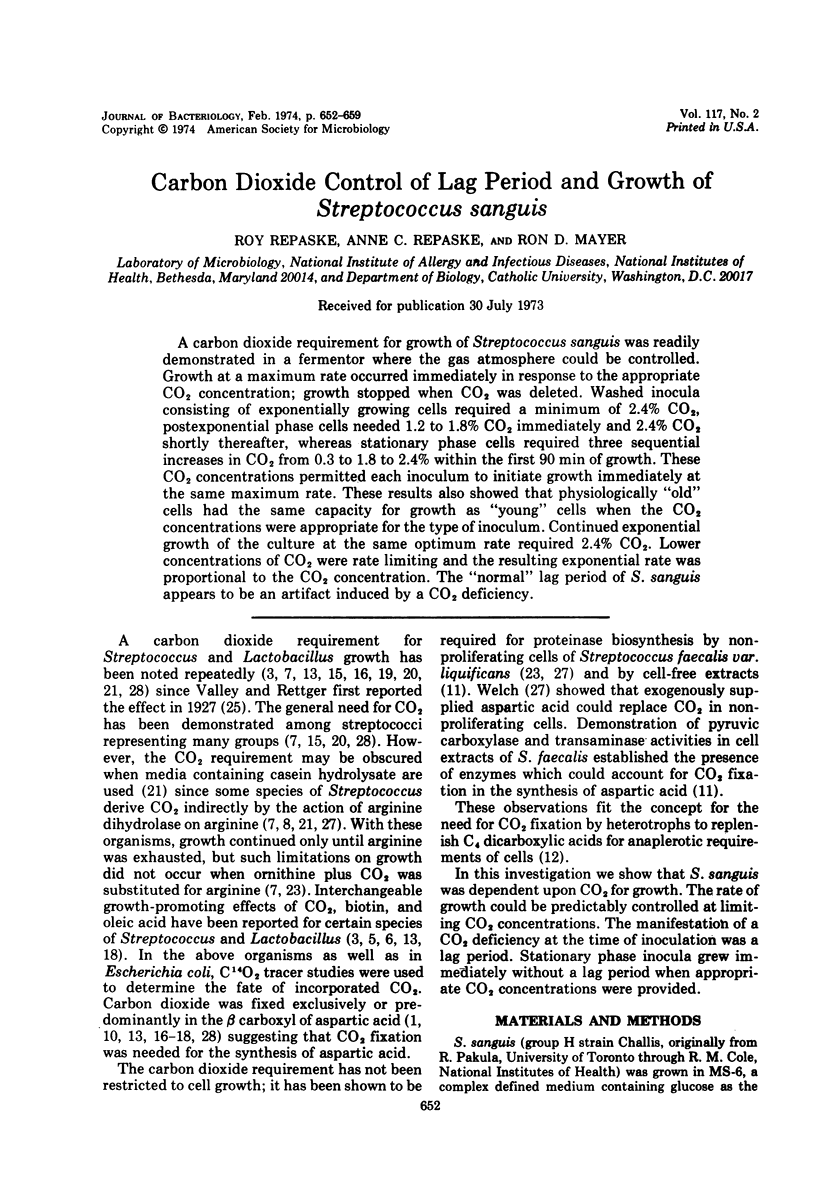

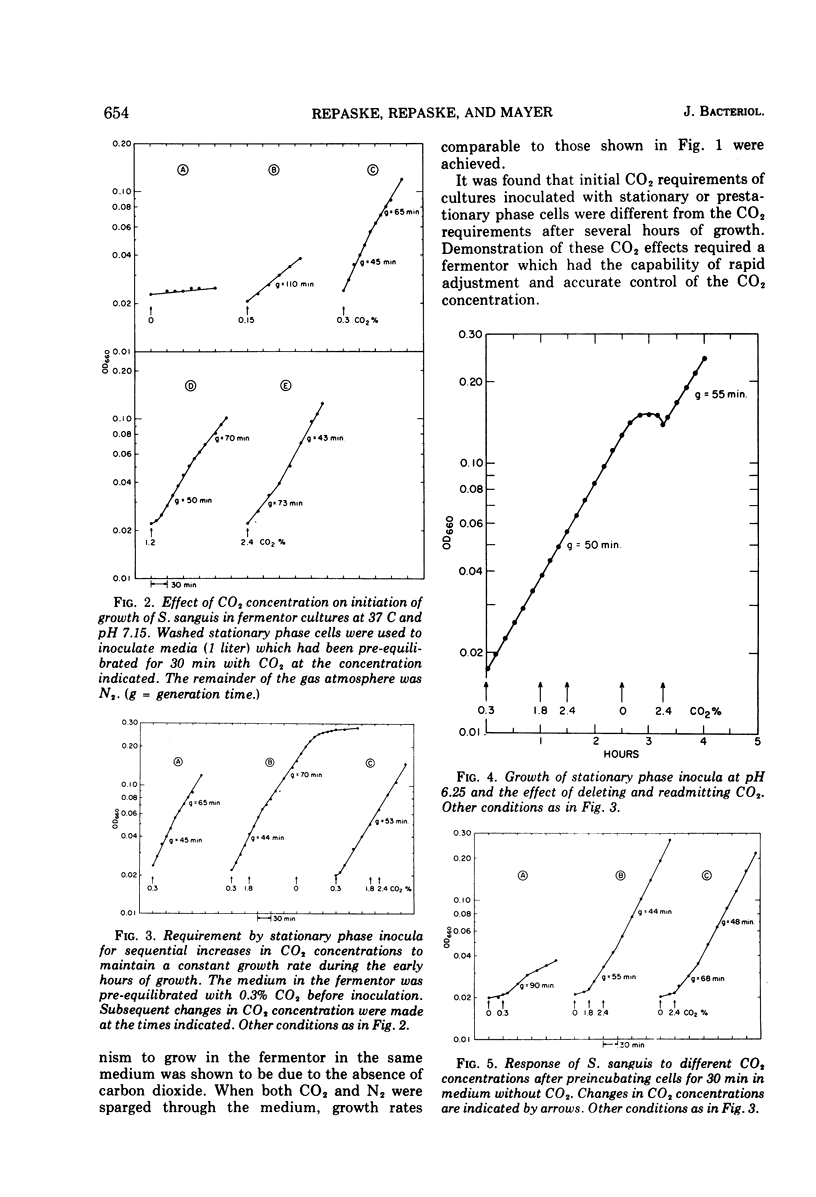
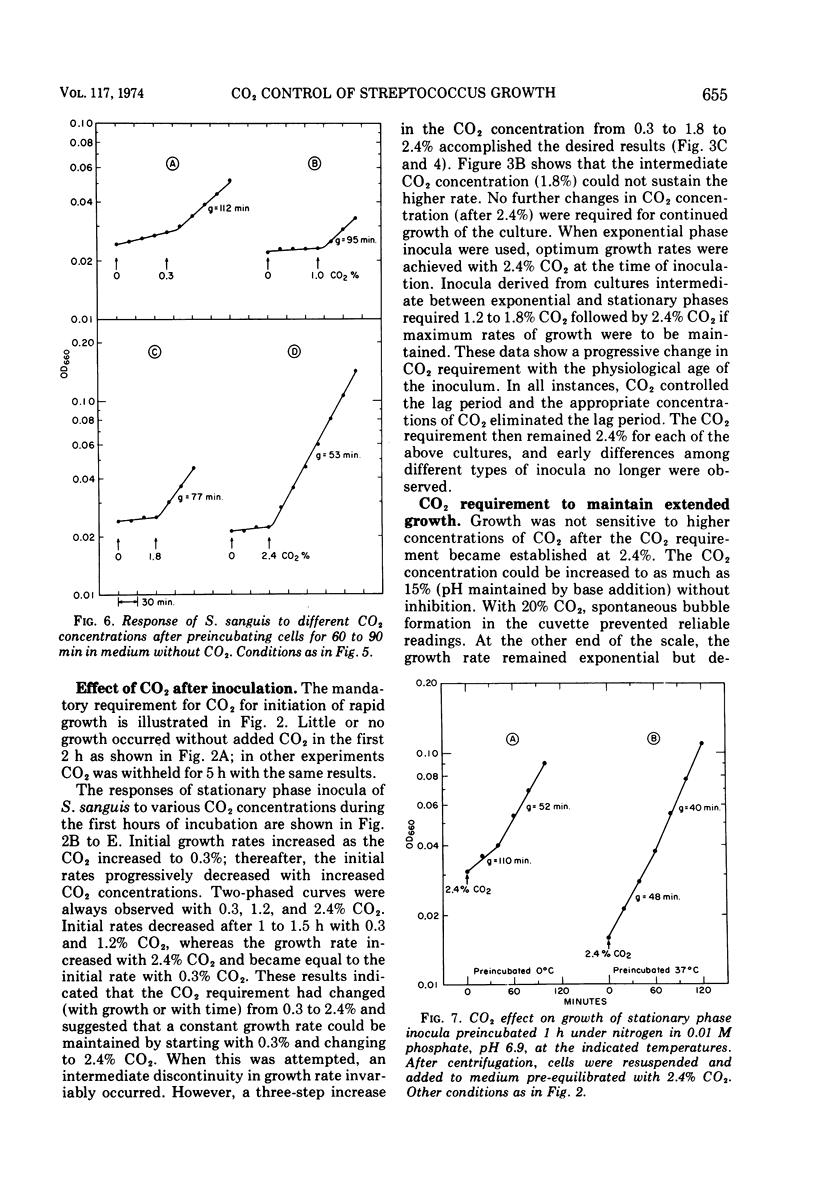
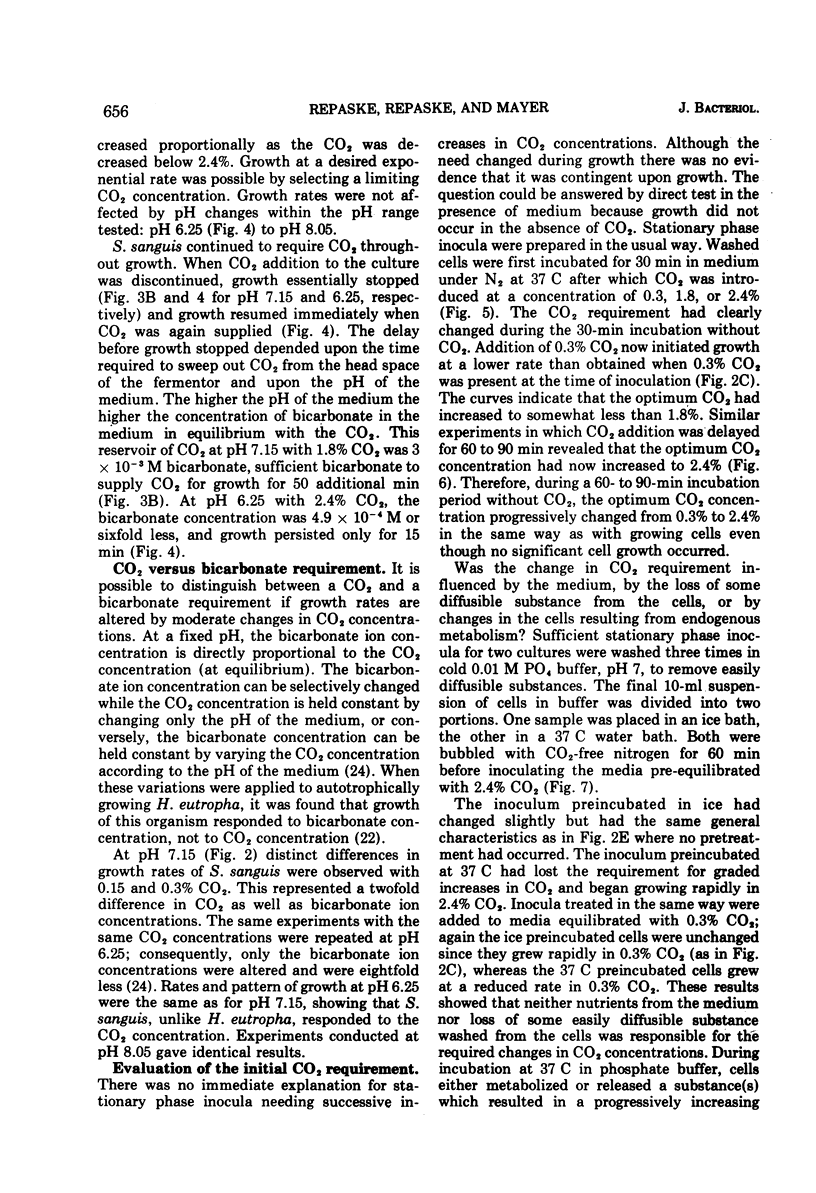
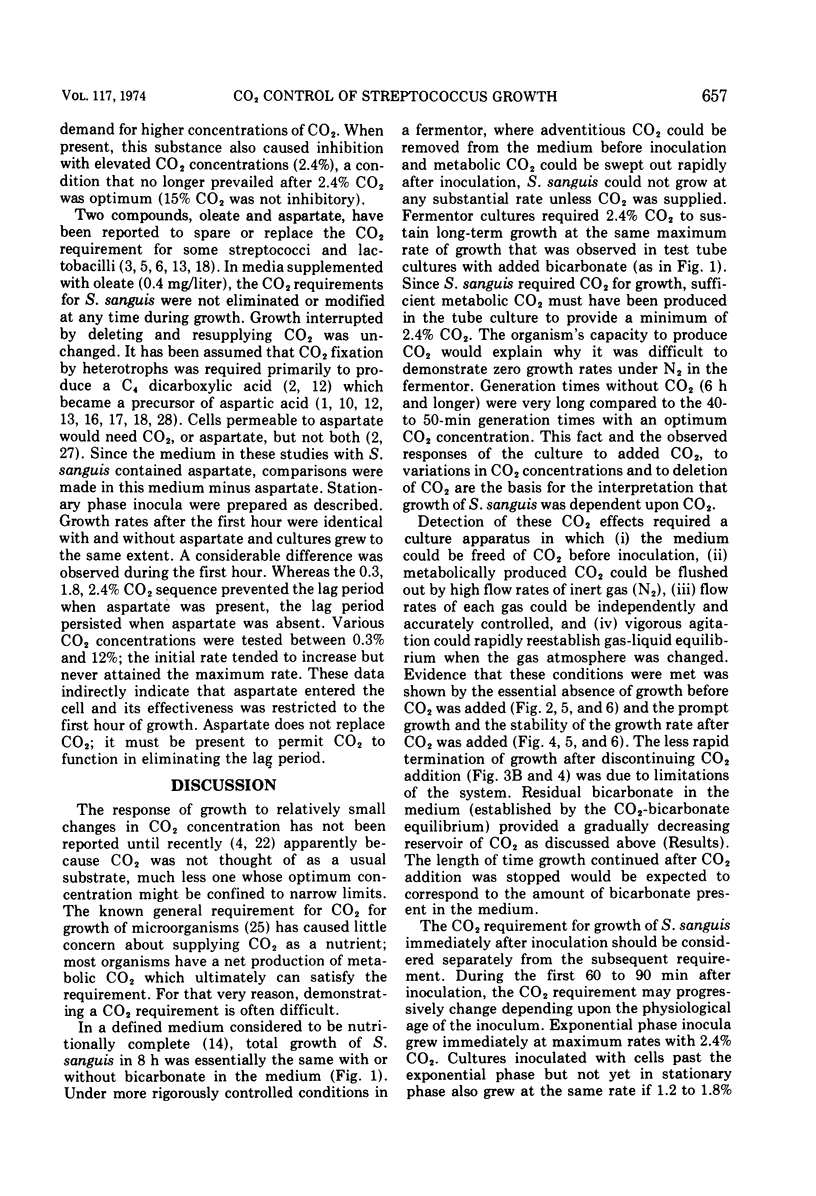
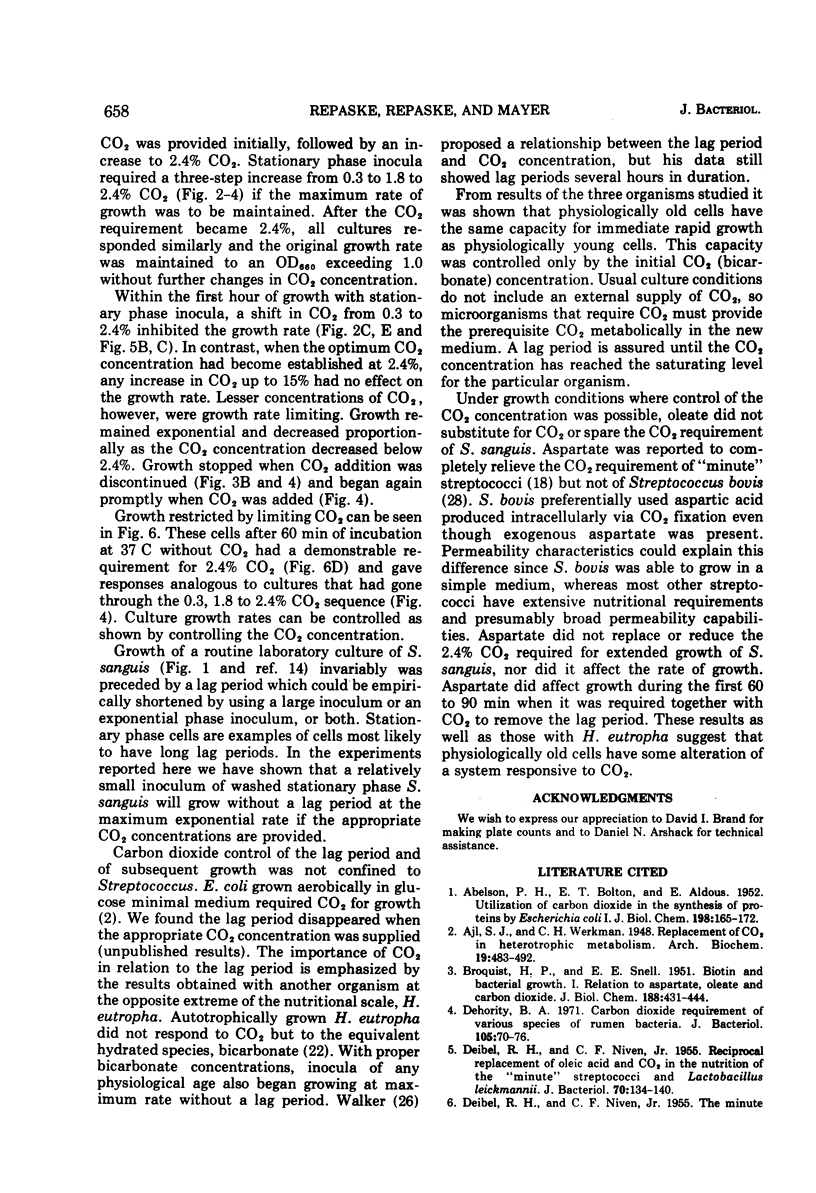
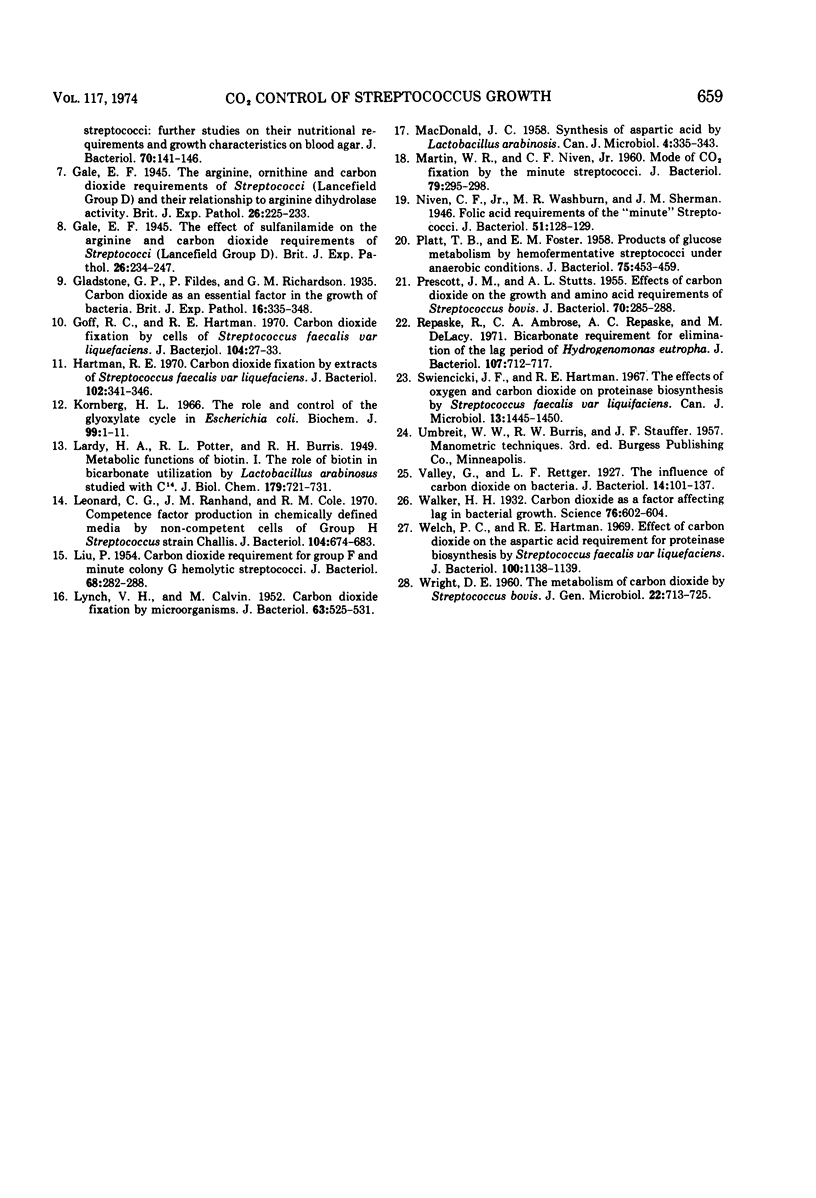
Selected References
These references are in PubMed. This may not be the complete list of references from this article.
- ABELSON P. H., BOLTON E. T., ALDOUS E. Utilization of carbon dioxide in the synthesis of proteins by Escherichia coli. I. J Biol Chem. 1952 Sep;198(1):165–172. [PubMed] [Google Scholar]
- BROQUIST H. P., SNELL E. E. Biotin and bacterial growth. I. Relation to aspartate, oleate, and carbon dioxide. J Biol Chem. 1951 Jan;188(1):431–444. [PubMed] [Google Scholar]
- DEIBEL R. H., NIVEN C. F., Jr Reciprocal replacement of oleic acid and CO2 in the nutrition of the minute streptococci and Lactobacillus leichmannii. J Bacteriol. 1955 Aug;70(2):134–140. doi: 10.1128/jb.70.2.134-140.1955. [DOI] [PMC free article] [PubMed] [Google Scholar]
- DEIBEL R. H., NIVEN C. F., Jr The minute streptococci: further studies on their nutritional requirements and growth characteristics on blood agar. J Bacteriol. 1955 Aug;70(2):141–146. doi: 10.1128/jb.70.2.141-146.1955. [DOI] [PMC free article] [PubMed] [Google Scholar]
- Dehority B. A. Carbon dioxide requirement of various species of rumen bacteria. J Bacteriol. 1971 Jan;105(1):70–76. doi: 10.1128/jb.105.1.70-76.1971. [DOI] [PMC free article] [PubMed] [Google Scholar]
- Goff R. C., Hartman R. E. Carbon dioxide fixation by cells of Streptococcus faecalis var. liquefaciens. J Bacteriol. 1970 Oct;104(1):27–33. doi: 10.1128/jb.104.1.27-33.1970. [DOI] [PMC free article] [PubMed] [Google Scholar]
- Hartman R. E. Carbon dioxide fixation by extracts of Streptococcus faecalis var. liquefaciens. J Bacteriol. 1970 May;102(2):341–346. doi: 10.1128/jb.102.2.341-346.1970. [DOI] [PMC free article] [PubMed] [Google Scholar]
- Kornberg H. L. The role and control of the glyoxylate cycle in Escherichia coli. Biochem J. 1966 Apr;99(1):1–11. doi: 10.1042/bj0990001. [DOI] [PMC free article] [PubMed] [Google Scholar]
- LIU P. Carbon dioxide requirement of group F and minute colony G hemolytic streptococci. J Bacteriol. 1954 Sep;68(3):282–288. doi: 10.1128/jb.68.3.282-288.1954. [DOI] [PMC free article] [PubMed] [Google Scholar]
- LYNCH V. H., CALVIN M. Carbon dioxide fixation by microorganisms. J Bacteriol. 1952 Apr;63(4):525–531. doi: 10.1128/jb.63.4.525-531.1952. [DOI] [PMC free article] [PubMed] [Google Scholar]
- Leonard C. G., Ranhand J. M., Cole R. M. Competence factor production in chemically defined media by noncompetent cells of group H Streptococcus strain Challis. J Bacteriol. 1970 Nov;104(2):674–683. doi: 10.1128/jb.104.2.674-683.1970. [DOI] [PMC free article] [PubMed] [Google Scholar]
- MACDONALD J. C. Synthesis of aspartic acid by Lactobacillus arabinosus. Can J Microbiol. 1958 Aug;4(4):335–343. doi: 10.1139/m58-036. [DOI] [PubMed] [Google Scholar]
- MARTIN W. R., NIVEN C. F., Jr Mode of carbon dioxide fixation by the minute streptococci. J Bacteriol. 1960 Feb;79:295–298. doi: 10.1128/jb.79.2.295-298.1960. [DOI] [PMC free article] [PubMed] [Google Scholar]
- PLATT T. B., FOSTER E. M. Products of glucose metabolism by homofermentative streptococci under anaerobic conditions. J Bacteriol. 1958 Apr;75(4):453–459. doi: 10.1128/jb.75.4.453-459.1958. [DOI] [PMC free article] [PubMed] [Google Scholar]
- PRESCOTT J. M., STUTTS A. L. Effects of carbon dioxide on the growth and amino acid metabolism of Streptococcus bovis. J Bacteriol. 1955 Sep;70(3):285–288. doi: 10.1128/jb.70.3.285-288.1955. [DOI] [PMC free article] [PubMed] [Google Scholar]
- Repaske R., Ambrose C. A., Repaske A. C., De Lacy M. L. Bicarbonate requirement for elimination of the lag period of Hydrogenomonas eutropha. J Bacteriol. 1971 Sep;107(3):712–717. doi: 10.1128/jb.107.3.712-717.1971. [DOI] [PMC free article] [PubMed] [Google Scholar]
- Swiencicki J. F., Hartman R. E. The effects of oxygen and carbon dioxide on proteinase biosynthesis by Streptococcus faecalis var. liquefaciens. Can J Microbiol. 1967 Nov;13(11):1445–1450. doi: 10.1139/m67-192. [DOI] [PubMed] [Google Scholar]
- Valley G., Rettger L. F. THE INFLUENCE OF CARBON DIOXIDE ON BACTERIA. J Bacteriol. 1927 Aug;14(2):101–137. doi: 10.1128/jb.14.2.101-137.1927. [DOI] [PMC free article] [PubMed] [Google Scholar]
- WRIGHT D. E. The metabolism of carbon dioxide by Streptococcus bovis. J Gen Microbiol. 1960 Jun;22:713–725. doi: 10.1099/00221287-22-3-713. [DOI] [PubMed] [Google Scholar]
- Walker H. H. CARBON DIOXIDE AS A FACTOR AFFECTING LAG IN BACTERIAL GROWTH. Science. 1932 Dec 23;76(1982):602–604. doi: 10.1126/science.76.1982.602. [DOI] [PubMed] [Google Scholar]
- Welch P. C., Hartman R. E. Effect of carbon dioxide on the aspartic acid requirement for proteinase biosynthesis by Streptococcus faecalis var. liquefaciens. J Bacteriol. 1969 Nov;100(2):1138–1139. doi: 10.1128/jb.100.2.1138-1139.1969. [DOI] [PMC free article] [PubMed] [Google Scholar]


